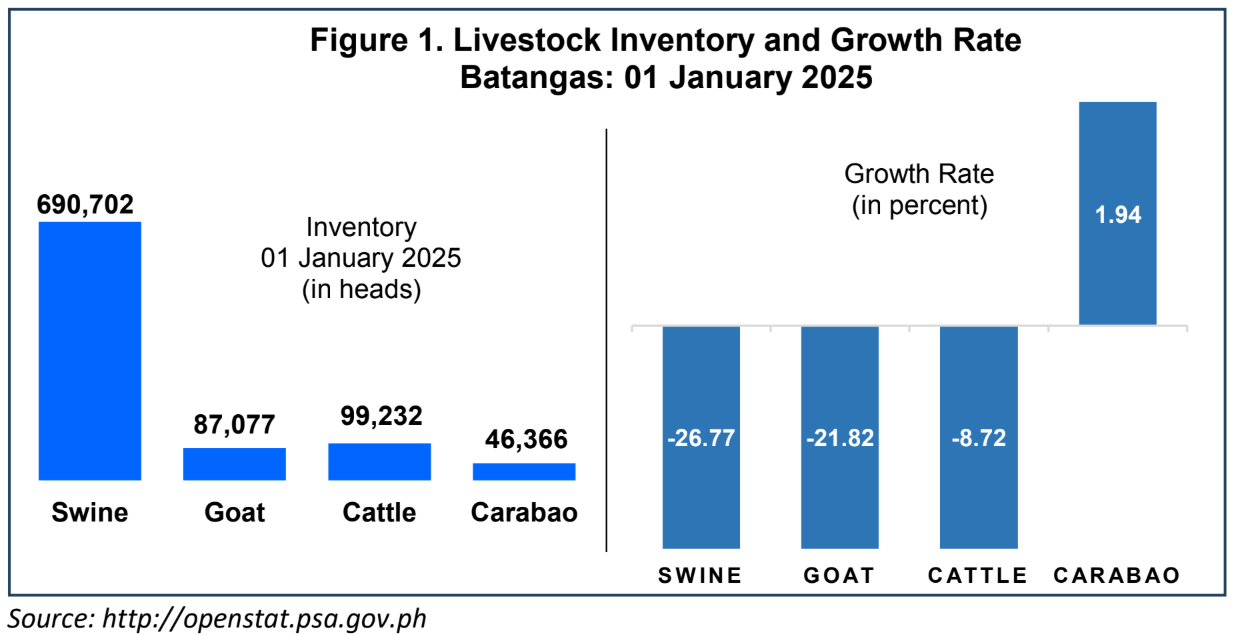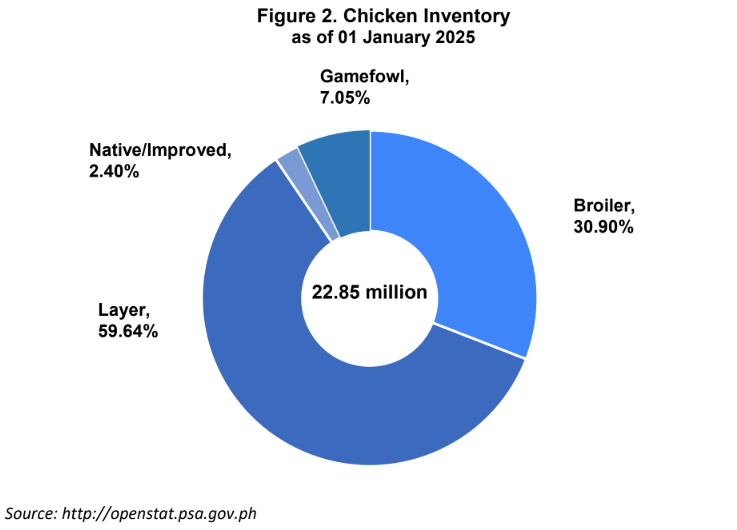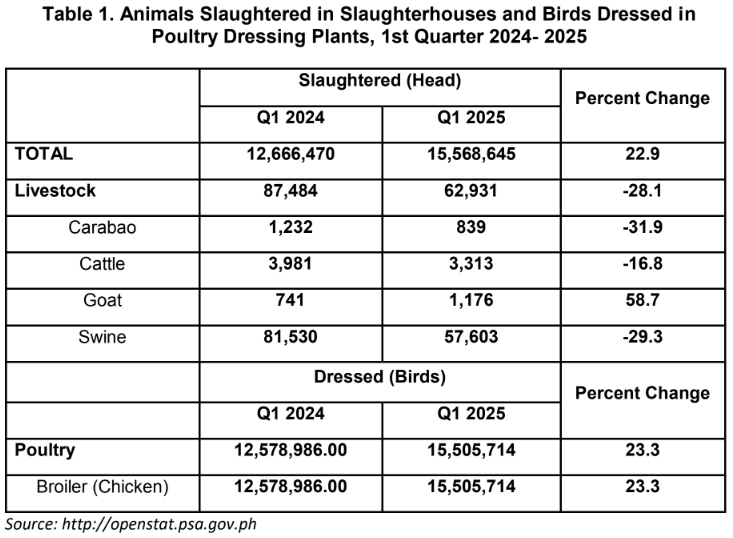
The total inventory of livestock animals in the province of Batangas for 1st Quarter of 2025 is shown in Figure 1. A total of 923,377 heads as of 01 January 2025. Swine had the highest inventory with 690,702 heads which is 26.77 percent decrease in the same period of 2024. This is because of lower beginning inventory in backyard farms due to high mortality brought by ASF outbreak last quarter 3. Backyard & commercial farms are hesitant to increase their stocks yet due to unavailability of vaccine for ASF. The inventory of goat is 87,077 heads, a decrease of 26.77 percent compared last year of the same period because of increased disposal of animals in backyard and commercial farms due to increasing demand as this is used as substitute for pork asthere is lack of pork in the province brought by ASF outbreak. Cattle registered 99,232 heads which is 8.72 percent decrease compared last year same period because of less marketable stocks for disposal due to lack of forage grass brought by hot weather. The inventory for Carabao posted 46,366 heads or 1.94 percent increase compared last year same quarter because of more caracows gave birth this quarter.
Other animals being monitored are horse and rabbit.

The total inventory of poultry commodities in the province of Batangas is 22,850,918 birds as of 01 January 2025. Batangas is one of the major producers of eggs in CALABARZON, Layer chicken posted the highest inventory with 13,627,983 birds or 59.64 percent out of the total inventory. About 5.23 percent increase compared to last year because of less culling rate due to high Egg Laying Efficiency Ratio (ELER) and high cost of Ready to Lay (RTL) pullets that’s why raisers opted not to change their stocks. The inventory of Broiler chicken is 7,062,035 birds or 30.90 percent share in the overall inventory of poultry commodities. It posted an increase of 205.73 percent increase compared to last year of the same period because raisers are encouraged to increase their stocks brought by increasing demand within and outside the province as chicken meat is used as pork substitute because of price increase of hogs. The Native/Improved chicken had an inventory of 549,340 birds or 2.40 percent share in the total inventory of poultry sector. Compared last year of the same period, it posted an increase of 5.66 percent because of decrease disposal of available stocks due to less demand from local buyers. The inventory of Gamefowl chicken is 1,611,560 birds, it showed an increase of 7.05 percent increase compared last year due to less stock available for disposal as raisers choose quality breeds for gamefowl.
Other poultry commodities being monitored are goose, turkey and quail.

The slaughtered/dressed data were from the administrative report from the Locally Registered Meat Establishments (LRMEs) and National Meat Inspection Service (NMIS). The total animals slaughtered in slaughterhouses in the province of Batangas in the 1st Quarter 2025 is 62,931 heads. A decrease of 28.1 percent or 24,553 heads compared last year. Carabao posted the highest percentage decrease with 31.9 percent or 393 heads less this quarter. On the other hand, Swine showed a decrease of 29.3 percent or 23,927 heads lesser than last year same quarter because of incidence of African Swine Fever (ASF) in the province.
The total slaughtered goat posted the highest increase of 58.7 percent or 435 heads more this quarter due to increasing demand as this is used as substitute for pork as there is lack of pork in the province and NCR brought by ASF outbreak last quarter 3. The total slaughtered cattle were 3,313 heads in the 1st Quarter of 2025 compared to 3,981 heads in the same quarter of 2024. This yields to a difference of 668 heads or 16.8 percent decrease.
The total dressed in the dressing plants in the province for the 1st Quarter of 2025 is 15,505,714 birds. This yields a difference of 2,926,728 birds or 23.3 percent increase because of higher demand from local buyers/traders and consumers. It’s also used as pork substitute due to incidence of ASF in the province.
TECHNICAL NOTES
The Performance Report of Livestock and Poultry presents the performance situation in terms of inventory of carabao, cattle, goat, swine, and by type of chicken and volume of slaughtered/ dressed in the slaughterhouses and poultry dressing plants in the province of Batangas. Moreover, data for this special release were collected by the Philippine Statistics Authority (PSA) through the two (2) major surveys namely:
a) The Backyard Livestock and Poultry Survey (BLPS) which is done quarterly an b) The Commercial Livestock and Poultry Survey (CLPS), data collection for swine farms, layer and broiler chicken farms is done quarterly while the semester conduct covers cattle, goat and duck commercial farms.
Another administrative survey that supplements the data requirements of the livestock and poultry sector is the Compilation of Data from Slaughterhouses and Poultry Dressing Plants (CDSPDP). This is done monthly and utilized administrative data from Locally Registered Meat Establishments (LRMEs) in the province which is in coordination with the Provincial Veterinary Office (PVO)
Animal Population (also Animal Inventory) - the actual number of animals (in head/bird) present in the establishment as of a specific reference date regardless of ownership.
Breeder - an animal raised to improve or maintain the bloodline of the present stock.
Contract Growing - the partnership of the animal-raising business owner and a company where their main goal is to raise animals until they reach a certain market size.
Draft Animals – animals raised for work purposes such as plowing, harrowing, hauling, etc.
Farmgate price - the price received by raisers for their produce at the location of establishment. Thus, marketing costs such as transport and other marketing cost (if any) incurred in selling the produce are not included in the farmgate prices.
Fowl - a term used to refer to a specific group of avian sharing common anatomical characteristics, e.g., chicken, duck, quail, and turkey.
Grand Parent Stock - a product between the crosses of two pure breeds that produced the parent stock.
Great Grand Parent Stock (GGP) – animals, both pure breed of origin, used to produce grandparent.
Grow-out (operational definition) – for the purpose of the survey, this is defined as the growing/raising/tending of birds from chicks to disposal. This includes independent growers and contract growers.
Household – A person or group of persons who sleep under the same dwelling unit and usually have a common arrangement in the preparation and consumption of food. The household members may not necessarily be related by ties of kinship, although they are usually relatives. In some instances, more than one household may occupy the same dwelling unit.
Household head – An adult member of the household, male or female who is responsible for the organization and care of the household, or who is regarded as such by the members of the household.
Livestock - farm animals kept or raised for consumption and work. For purposes of survey, livestock covers only those that are tended/raised by an establishment.
Other Animals – refers to commodities that are not yet included in the L&P statistics released by the PSA. This includes sheep, horse, rabbit, quail, turkey, and other animals that are not specified in the questionnaire.
Poultry - a collective term for all domesticated avian for the purpose of food consumption or, the carcass of such avian are processed for human consumption.
Egg Laying Efficiency Ratio - ratio of the number of layers that have actually laid eggs to total laying flock.
Parent Stock - the parents of commercial strains of animals possessing all the qualities of a good stock which include being fast-growing, with good feed conversion rate, being resistant to disease, being meaty, and being adapted to the environmental conditions. Parent stocks are the end stocks of breeders.
Purpose - the main reason for the animals being kept. This is usually straightforward on L&P establishments; as specific breeds of animal are used for certain purposes. The specific purposes recorded will depend on the type of livestock and poultry and local conditions. For this survey, the purpose includes breeding, fattening, dairying, grow-out, and egg production.
Operator – a person who takes the technical and administrative responsibility of managing the day-to-day farm operation. He/she is responsible for making the decisions of the operation, including the management and supervision of hired labor. The operator may work alone or with members of his/her household or may employ others to work.
Volume of Production (operational definition) - the number of tended/raised animals disposed for slaughter/dressing including animals shipped-out for slaughter/dressing (in “head/bird” and in “liveweight equivalent”).

